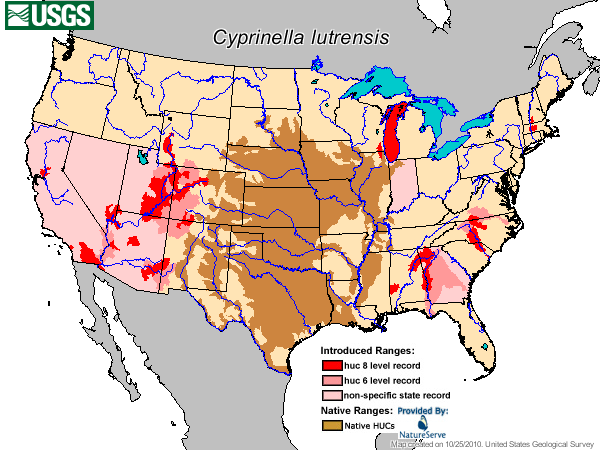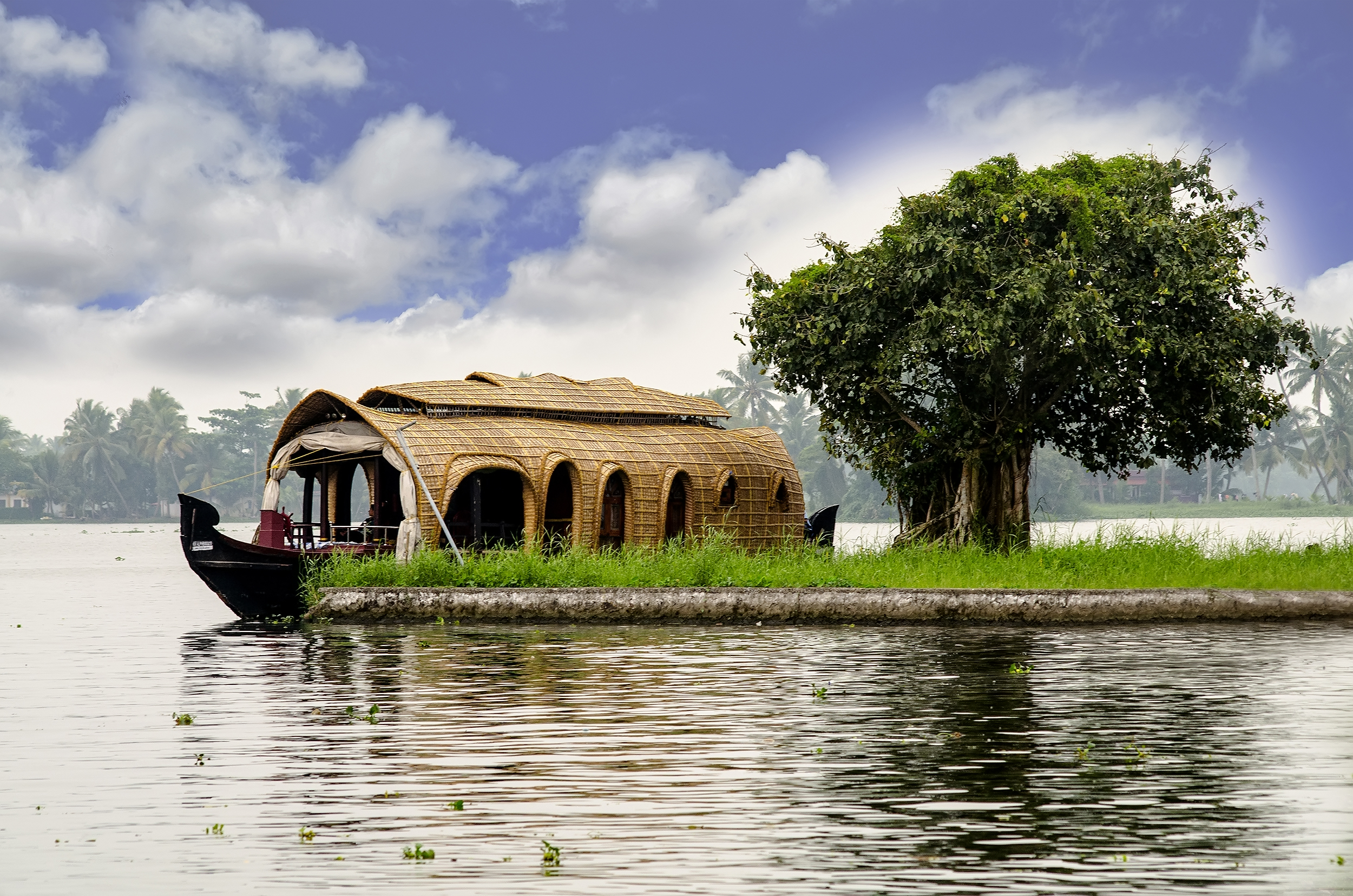|
Cyprinella Lutrensis
The red shiner or red-horse minnow (''Cyprinella lutrensis'') is a species of freshwater ray-finned fish in the family Leuciscidae, the shiners, daces and minnows. They are deep-bodied and laterally compressed,Farringer R.T., III, A.A. Echelle, and S.F. Lehtinen. 1979. Reproductive cycle of the red shiner, ''Notropis lutrensis'', in central Texas and south central Oklahoma. ''Transactions of the American Fisheries Society,'' 108, 271–276. and can grow to about in length. For most of the year, both males and females have silver sides and whitish abdomens. Males in breeding coloration, though, have iridescent pink-purple-blue sides and a red crown and fins (except the dorsal fin which remains dark). Red shiners can live up to three years. They are omnivorous; they eat both aquatic and terrestrial invertebrates, as well as algae. Red shiners have also been known to eat the eggs and larvae of native fish found in locations where they have been introduced.Ruppert, J.B., Muth, R.T., ... [...More Info...] [...Related Items...] OR: [Wikipedia] [Google] [Baidu] |
Spencer Fullerton Baird
Spencer Fullerton Baird (; February 3, 1823 – August 19, 1887) was an American naturalist, ornithologist, ichthyologist, Herpetology, herpetologist, and museum curator. Baird was the first curator to be named at the Smithsonian Institution. He eventually served as assistant Secretary of the Smithsonian from 1850 to 1878, and as Secretary from 1878 until 1887. He was dedicated to expanding the natural history collections of the Smithsonian which he increased from 6,000 specimens in 1850 to over 2 million by the time of his death. He also served as the U.S. United States Fish Commission, Commissioner of Fish and Fisheries from 1871 to 1887 and published over 1,000 works during his lifetime. Early life and education Spencer Fullerton Baird was born in Reading, Pennsylvania in 1823. His mother was a member of the prominent Philadelphia Biddle family; he was a nephew of Speaker of the Pennsylvania Senate Charles B. Penrose and a first cousin, once removed, of U.S. Senator Boies Penr ... [...More Info...] [...Related Items...] OR: [Wikipedia] [Google] [Baidu] |
Riffle
A riffle is a shallow landform in a flowing channel. Colloquially, it is a shallow place in a river where water flows quickly past rocks. However, in geology a riffle has specific characteristics. Topographic, sedimentary and hydraulic indicators Riffles are almost always found to have a very low discharge compared to the flow that fills the channel (approximately 10–20%), and as a result the water moving over a riffle appears shallow and fast, with a wavy, disturbed water surface. The water's surface over a riffle at low flow also has a much steeper slope than that over other in-channel landforms. Channel sections with a mean water surface slope of roughly 0.1 to 0.5% exhibit riffles, though they can occur in steeper or gentler sloping channels with coarser or finer bed materials, respectively. Except in the period after a flood (when fresh material is deposited on a riffle), the sediment on the riverbed in a riffle is usually much coarser than on that in any other in-chan ... [...More Info...] [...Related Items...] OR: [Wikipedia] [Google] [Baidu] |
Fish Described In 1853
A fish (: fish or fishes) is an aquatic, anamniotic, gill-bearing vertebrate animal with swimming fins and a hard skull, but lacking limbs with digits. Fish can be grouped into the more basal jawless fish and the more common jawed fish, the latter including all living cartilaginous and bony fish, as well as the extinct placoderms and acanthodians. In a break to the long tradition of grouping all fish into a single class (Pisces), modern phylogenetics views fish as a paraphyletic group. Most fish are cold-blooded, their body temperature varying with the surrounding water, though some large active swimmers like white shark and tuna can hold a higher core temperature. Many fish can communicate acoustically with each other, such as during courtship displays. The study of fish is known as ichthyology. The earliest fish appeared during the Cambrian as small filter feeders; they continued to evolve through the Paleozoic, diversifying into many forms. The earliest fish wi ... [...More Info...] [...Related Items...] OR: [Wikipedia] [Google] [Baidu] |
Freshwater Fish Of The United States
Fresh water or freshwater is any naturally occurring liquid or frozen water containing low concentrations of dissolved salt (chemistry), salts and other total dissolved solids. The term excludes seawater and brackish water, but it does include non-salty mineral water, mineral-rich waters, such as chalybeate springs. Fresh water may encompass frozen water, frozen and meltwater in ice sheets, ice caps, glaciers, snowfields and icebergs, natural precipitations such as rainfall, snowfall, hail/ice pellets, sleet and graupel, and surface runoffs that form inland bodies of water such as wetlands, ponds, lakes, rivers, streams, as well as groundwater contained in aquifers, subterranea (geography), subterranean subterranean river, rivers and underground lake, lakes. Water is critical to the survival of all living organisms. Many organisms can thrive on salt water, but the great majority of vascular plants and most insects, amphibians, reptiles, mammals and birds need fresh water to sur ... [...More Info...] [...Related Items...] OR: [Wikipedia] [Google] [Baidu] |
Coosa River
The Coosa River is a tributary of the Alabama River in the U.S. states of Alabama and Georgia (U.S. state), Georgia. The river is about long.U.S. Geological Survey. National Hydrography Dataset high-resolution flowline dataThe National Map, accessed April 27, 2011 The Coosa River begins at the confluence of the Oostanaula River, Oostanaula and Etowah River, Etowah rivers in Rome, Georgia, and ends just northeast of the Alabama state capital, Montgomery, Alabama, Montgomery, where it joins the Tallapoosa River to form the Alabama River just south of Wetumpka, Alabama, Wetumpka. Around 90% of the Coosa River's length is located in Alabama. Coosa County, Alabama and Etowah County, Alabama are located on the Coosa River. The Coosa is one of Alabama's most developed rivers. Most of the river has been impounded, with Alabama Power, a unit of the Southern Company, owning seven dams and power station, powerhouses on the Coosa River. The dams produce hydroelectric power, but they are ... [...More Info...] [...Related Items...] OR: [Wikipedia] [Google] [Baidu] |
Cyprinella Venusta
The blacktail shiner (''Cyprinella venusta'') is a species of freshwater ray-finned fish in the family Leuciscidae, the shiners, daces and minnows. This fish is found in the United States. Description and anatomy The blacktail shiner is a somewhat slender minnow with 8–9 rays on the anal fin, and a prominent black spot at the base of the caudal fin (tail fin). The back is usually yellowish-olive, and the sides are silvery with hints of blue. Adults usually reach in length. The blacktail shiner has a large, black caudal spot which distinguishes it from most other minnows. The caudal spot of the blacktail shiner may be faint, especially in populations inhabiting turbid waters, and they could likely be confused with the red shiner (''C. lutrensis''); however, the red shiner has 9 anal rays (versus 8) and usually 35 or fewer lateral scales (versus 36 or more). Geographic distribution The blacktail shiner occurs in Gulf of Mexico drainages from Suwannee River, Georgia and Florida, ... [...More Info...] [...Related Items...] OR: [Wikipedia] [Google] [Baidu] |
Plains Killifish
''Fundulus zebrinus'' is a species of fish in the Fundulidae known by the common name plains killifish. It is native to North America, where it is distributed throughout the Mississippi River, Colorado River, and Rio Grande drainages, and other river systems; many of its occurrences represent introduced species, introduced populations. Description This fish grows up to about , with a maximum length of .Rahel, F. J. and L. A. ThelPlains Killifish (''Fundulus zebrinus''): A Technical Conservation Assessment.Prepared for the USDA Forest Service, Rocky Mountain Region, Species Conservation Project. March 18, 2004. Its lifespan is up to 3 years, but most fish do not exceed two. It has a flat head with a protruding jaw that allows it to feed at the water's surface. It is variable in color, being brown, black, greenish, or straw-colored, with paler yellowish or silvery coloration on the belly. The fish is striped with the 12 to 28 dark vertical bars that give the species its scientific ... [...More Info...] [...Related Items...] OR: [Wikipedia] [Google] [Baidu] |
Invasive Species
An invasive species is an introduced species that harms its new environment. Invasive species adversely affect habitats and bioregions, causing ecological, environmental, and/or economic damage. The term can also be used for native species that become harmful to their native environment after human alterations to its food web. Since the 20th century, invasive species have become serious economic, social, and environmental threats worldwide. Invasion of long-established ecosystems by organisms is a natural phenomenon, but human-facilitated introductions have greatly increased the rate, scale, and geographic range of invasion. For millennia, humans have served as both accidental and deliberate dispersal agents, beginning with their earliest migrations, accelerating in the Age of Discovery, and accelerating again with the spread of international trade. Notable invasive plant species include the kudzu vine, giant hogweed (''Heracleum mantegazzianum''), Japanese knotw ... [...More Info...] [...Related Items...] OR: [Wikipedia] [Google] [Baidu] |
Maravillas Creek
Maravillas Creek is a river in Texas. It is a tributary of the Rio Grande. See also * List of rivers of Texas * List of tributaries of the Rio Grande Tributary, Tributaries and sub-tributaries are hierarchically listed in order from the mouth of the Rio Grande upstream. Major dams and reservoir lakes are also noted. * San Juan River (Tamaulipas), San Juan River, or Rio San Juan (Tamaulipas, Nue ... References * * *USGS Hydrologic Unit Map - State of Texas (1974) External links * Tributaries of the Rio Grande Rivers of Texas Bodies of water of Brewster County, Texas {{Texas-river-stub ... [...More Info...] [...Related Items...] OR: [Wikipedia] [Google] [Baidu] |
Subspecies
In Taxonomy (biology), biological classification, subspecies (: subspecies) is a rank below species, used for populations that live in different areas and vary in size, shape, or other physical characteristics (Morphology (biology), morphology), but that can successfully interbreed. Not all species have subspecies, but for those that do there must be at least two. Subspecies is abbreviated as subsp. or ssp. and the singular and plural forms are the same ("the subspecies is" or "the subspecies are"). In zoology, under the International Code of Zoological Nomenclature, the subspecies is the only taxonomic rank below that of species that can receive a name. In botany and mycology, under the International Code of Nomenclature for algae, fungi, and plants, other infraspecific name, infraspecific ranks, such as variety (botany), variety, may be named. In bacteriology and virology, under standard International Code of Nomenclature of Prokaryotes, bacterial nomenclature and virus clas ... [...More Info...] [...Related Items...] OR: [Wikipedia] [Google] [Baidu] |
Red Shiner US Distribution Map
Red is the color at the long wavelength end of the visible spectrum of light, next to orange and opposite violet. It has a dominant wavelength of approximately 625–750 nanometres. It is a primary color in the RGB color model and a secondary color (made from magenta and yellow) in the CMYK color model, and is the complementary color of cyan. Reds range from the brilliant yellow-tinged scarlet and vermillion to bluish-red crimson, and vary in shade from the pale red pink to the dark red burgundy. Red pigment made from ochre was one of the first colors used in prehistoric art. The Ancient Egyptians and Mayans colored their faces red in ceremonies; Roman generals had their bodies colored red to celebrate victories. It was also an important color in China, where it was used to color early pottery and later the gates and walls of palaces. In the Renaissance, the brilliant red costumes for the nobility and wealthy were dyed with kermes and cochineal. The 19th century brought the ... [...More Info...] [...Related Items...] OR: [Wikipedia] [Google] [Baidu] |
Backwater (river)
A backwater is a part of a river in which there is little or no current. It can refer to a branch of a main river, which lies alongside it and then rejoins it, or to a body of water in a main river, backed up by the sea tide or by an obstruction such as a dam. Manmade restrictions to natural stream flow or temporary natural obstructions such as ice jams, vegetation blockage, or flooding of a lower stream can create backwater. Alternative channel If a river has developed one or more alternative courses in its evolution, one channel is usually designated the main course, and secondary channels may be termed backwaters. The main river course will usually have the fastest stream and will likely be the main navigation route; backwaters may be shallower and flow more slowly, if at all. Some backwaters are rich in mangrove forest. This results in a more diverse environment of scientific interest and worthy of preservation. Backwaters also provide opportunities for leisure activities su ... [...More Info...] [...Related Items...] OR: [Wikipedia] [Google] [Baidu] |







